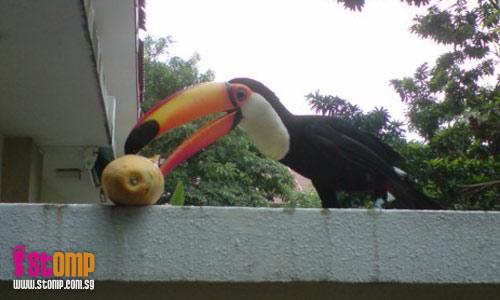
Jurong Bird Park says the exotic bird which paid a visit to STOMPer Cheryl's house is a Toco Toucan.
Earlier, Cheryl had sent in photos and a video of an exotic bird perched on top of her garden wall, eating a papaya offered by her.
STOMP had sought Jurong Bird Park's help in identifying the species.
In an e-mail sent to STOMP today(21 Jan), Jurong Bird Park says:
"The bird in the picture is a Toco Toucan. Toco Toucan is the largest in the Toucan family and they originate from South America.
"It is easily distinguished by its broad and long beak which appears to be heavy but is actually lightweight because it is hollow and mainly made up of keratin."
Related story:
Exotic bird pays surprise visit to my house
Update: Toucan sighting (5th February 2009)
Related post: Exotic bird pays surprise visit to my house (19th January 2009)
The toco toucan (Ramphastos toco) is so unmistakable that getting the Jurong BirdPark to identify the bird is really quite superfluous in this case.
As mentioned, toucan bills are extremely lightweight, despite their massive size. Here's a website that describes the internal structure of the toucan's bill, and also discusses some possible technological applications.
Toucan beaks are built lightweight and strong thanks to a rigid foamy inside and layers of fibrous keratin tile outside.
The structure of the toucan beak teaches us principles of composite material design for light-weight strength and stiffness. Despite its large size (a third of the length of the bird) and considerable strength, the toucan beak comprises only one twentieth the bird's mass. While the large strong beak is useful in foraging, defense and attracting mates, its low density is essential for the toucan to retain its ability to fly. The beak's solid outer shell sandwiches within it a closed-cell, foam-like structure made of struts which, together with thin protein membranes, enclose variably shaped air spaces. The solid shell layer is built of overlapping, hexagonally-shaped thin plates of keratin protein held together by an organic glue. The internal closed-cell structural support is comprised of keratin fibers with greater mineralization, by calcium and other salts, than in either the membranes or the solid shell layers to increase hardness. The closed cell structure offers a more complex energy absorption capacity and resistance to compression than the bending deformation typical of open celled structures. The rotational deformation of cell walls, stretching of membranes, and the internal gas pressure all contribute to those features. There is a synergistic effect of the shell layer and foam-like interior elements that together gives it greater strength than the sum of the strengths of those individual parts. Material designs inspired by the structure of the toucan beak could offer the properties of low weight with high stiffness and strength, as well as good energy absorption capacity and insulation value, such as could be useful in developing crash resistance in vehicles without compromising fuel economy.
Even though hornbills are not closely related to toucans, they also possess these weight-saving adaptations. Here's a page with excellent photos showing how highly pneumatised the skulls of a toco toucan, rhinoceros hornbill (Buceros rhinoceros) and helmeted hornbill (Buceros vigil) are.
Does this mean that we can call hornbills and toucans air-heads?